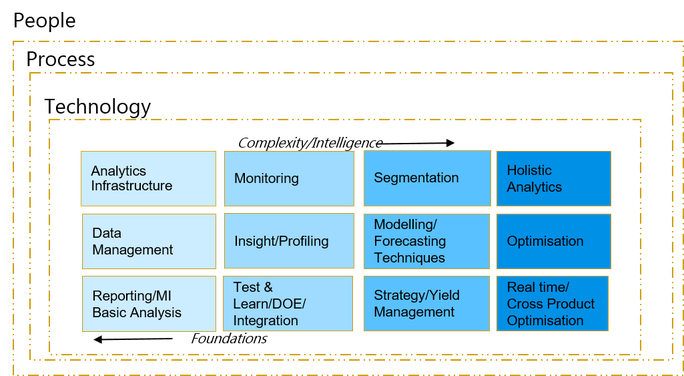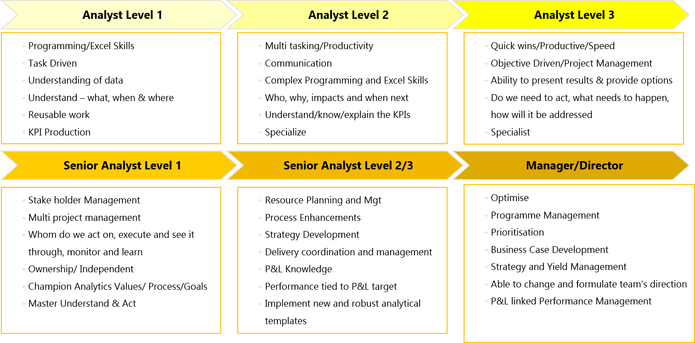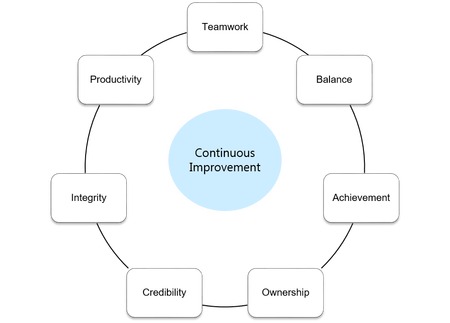|
Lay down three simple capabilities as foundations for your approach and analytics practice – Understanding, Action, Optimisation
0 Comments
 Analytics - The business critical function You may recall in an earlier blog I talked about why analytics is a critical function for any world class business and that in the process of turning data into profit, the 3 key enablers are People, Process and Technology. Understanding where you are in each of these key areas is important in order to progress and to create a first class analytics practice. As part of this, you need to undertake as a starting point a SWOT analysis for each aspect. On completion, create a road map (bottom up and top down) within the constraints you are operating in. Once the road map is built it is critical that the business: · Prioritises the development: 80-20 rule · Commits to timescales (all staff) · Be excited and make the Change! Once the change is in place commit to continuous improvement, build the team and help individuals grow so they can evolve from managing the foundations to delivering increasingly complex analytical models. A final reminder on the importance of having the right people in place to ensure that your data works as hard for the business as it can. A good analytics team with the right leadership will have an exponential impact on the business, which will in turn build confidence in the team to deliver. The fastest growing and most profitable businesses in the world all understand the value of data and invest heavily in their analytics teams and their leadership. If you haven’t already, then perhaps you should start by investigating how you develop your team. At Blue Label Consulting, we have a proven track record in helping businesses determine where they are along the journey and can help up skill your people as well as deliver critical analytics projects. If you want to find out more please contact me here. Brendan Jayagopal Blue label Consulting Difference between a forecast and forecast by a strong analytics leader
The softer skills in Analysts play a dominant role in creating a first class forecast that is dependable and instils confidence within the business. By now you would have established a knowledge of skill sets within your analytics practice and gained an understanding of the benefits an analytics leader can bring to the party versus a good manager. Nowhere is this more apparent than when considering and delivering forecasts. Having spent considerable time working for businesses in different industries and markets, I have seen the difference that adding soft skills to core technical requirements can make to delivery of a forecast. A good forecast will deliver a technical model with a low % error, will be robust, stable and scalable and fix any divergence. All of which are great but in order to get traction within the business it needs to be believed. A first class forecast is not only technically sound and accurate but is also communicated succinctly and timely, is believable and convincing and able to flex to business strategy. This is only achievable with a strong leader who is proactive and eager to understand everything at the most granular available interval and who can engage the action team to deliver quickly. In short, technical capability is important but a leader that understands the business requirements and how data adds real value coupled with the ability to communicate and influence at board level can change company fortunes. Brendan Jayagopal Blue Label Consulting  In my last blog I talked about the importance of understanding what level of maturity your analytics practice is at. Today I want to look at the different skillsets found at different levels of analytics departments to help you understand where your team is. I have broken it down into 6 different levels as below but ahead of that, it’s worth remembering that in order for you to develop a great team it is vital that the team have transparency in terms of progressing their careers and the core skills they would need to master to get there. As you can see from the above chart, as you move through each level we move from individuals who have basic programming and Excel skills, to those who are objective driven and specialist operators understanding the importance of why and how the objective benefits the business. Eventually, having good operators isn’t enough. You also need analysts who are good stakeholder managers, who champion analytics values and are capable of multi project management. Clearly having the skill sets is critical, but skills alone won’t make enough difference. In order to develop such a team you also need a strong leader or leadership team who understand the value data that can bring in supporting the business strategy and an analytics lead who has the ability to influence at senior levels. Brendan Jayagopal Blue Label Consulting  Understanding what analytics capability you need as a business is important and once done, you also need to understand where you are and how you can upgrade your team to the level required. In essence, you need to understand the business big picture in order to build a high performing team that allows you to maximise business value. Mature analytics teams are generally those that are:
Whereas less mature teams have the basic skills but are:
Once you have a view, you need to identify how you can move your team through the levels to reach the level your business needs it to be and the time that journey might take. Finally and critically, do you have senior management commitment? This is probably more critical than any other element and the one that most businesses often only pay lip service to. Are you ready for the change? Brendan Jayagopal Blue Label Consulting  Continuous Improvement and the importance of reinforcing Core Values. No matter how good your data analytics practice is there needs to be a consistent approach to building the best team possible to derive the best value from your data analytics. To do this, there are a number of key elements that you need to put in play. Teamwork It's important that all within the data analytics team work together for the common goals of the business and that they proactively share their skills and knowledge to support each other. Balance While you should expect your teams to work hard, you also need to be flexible to balance the needs of individuals with those of the business. Prioritising and getting the balance right between BAU work, projects and critical work allows you to maintain the balance between getting it right and getting it done. Achievement Strive to be successful and deliver what you promise, recognise that team success is as important as individual success and always recognise success and reward it appropriately. Ownership Ownership is important and individuals should be encouraged to look at the business and its values as their own and take responsibility for what they do and to be proactive in making things happen. Credibility It is also important for the business that all are encouraged to look for inspiration inside and outside the business and that individuals aim to proactively learn new techniques and methods. This could then lead to individuals aiming to solve problems and offer possible options for resolution, rather than simply bringing a problem for someone else to resolve. Integrity A key element of almost any set of values is integrity. Yet it is often one that senior leadership forget when looking at managing their patch of turf. Clearly what should be in play is that all should aim to do the right thing, to tell it how it is, promise what you can deliver and then deliver it. Productivity At the end of the day it's the outputs that count. Therefore, it's important to instill the right values to aim to get it right first time by thinking ahead and juggling priorities to make sure you get the most out of each hour. Any business that can deliver continuous improvement using some or all of the above has more than a good chance of creating a world class business and a first class data analytics practice. Next up I will talk about how you determine the maturity levels of your Analytics team and how you move from basics to mastery. Brendan Jayagopal Blue Label Consulting  Last time I talked about how important it is to remember that while all businesses should be data driven, it is critical that the data referred to is 'business driven'. And by that I mean that having the right data, structured in the right way will help you to facilitate and better inform your business decisions. In order to develop this, you need to recognise the multi-facetted or multi-dimensional challenge that every business faces when trying to turn data into profit. 12 core modules These modules range in increasing complexity from putting the infrastructure in place to developing real time business decisioning. A first class Analytics practice will address these 12 core analytical modules whilst also continuously developing their people, processes and technology. In order for this to work however, it is important that the business leadership is fully supportive of the challenges that such a function faces when dealing with the continual demands for information from other business departments and the cost implications of incorrect prioritisation. The best businesses in the world manage these challenges and that is why they are able to take that raw data the business generates and turn it into not just knowledge but profit. The next element of creating a first class analytics practice is something that all good businesses and departments should follow, but many don't - Managing Core Values and Continuous Improvement. Brendan Jayagopal Blue Label Consulting  Following on from my blog about Laying the Foundations for a first class analytics function I thought I would expand next on the key enablers. Analytics is a critical function for any world class business and the 3 key enablers in any such business are People, Process and Technology. Perhaps not a new concept but it is an important one nonetheless. People It is important that you have individuals with the right investigative attitude and skill set who are also commercial and technically proficient. Then you create a lean structure that that has continuous improvement at its centre and enables individuals within it to believe and practice core values. People with a can-do attitude that believe in analysis and the importance of extracting information that adds value to the business can and will add real value as long as you support them with process and technology. Process Like any other part of the business, it’s important that the right processes are in place to help prioritise activity based on a value assessment and then create an appropriate analysis process and research library with established methodology for others in the team to follow. Clearly, an appropriate project management system should be engaged together with a common analysis methodology and continuous training programmes. Simply put, the process should begin with the end in mind and be methodological in its approach Technology The technology you put in place should be appropriate to the current and near future requirements of the business. You need to look at the options and compare systems based on such elements as Speed of Analysis vs Accuracy, Standalone best of breed vs a Complete solution vs In-house build, Complexity vs Maintenance vs Benefits and Future Proofing or Scalability Once in place core analytical modules can then be developed to undertake complex analysis such as modelling, segmentation, or cross product optimisation. These key enablers combined with continuously developing your people, processes and technology provide a way of turning Data into Profit. Next time I will expand on how turning data into profit requires the data function to be aligned to the business supported by good process, analytical skills and technology capable of managing complex data. Brendan Jayagopal Blue Label Consulting |
Brendan jayagopalBrendan launched Blue Label Consulting in 2011 to help businesses solve their data related business challenges. CategoriesArchives |
Our Services |
Our Clients |
|

 RSS Feed
RSS Feed
